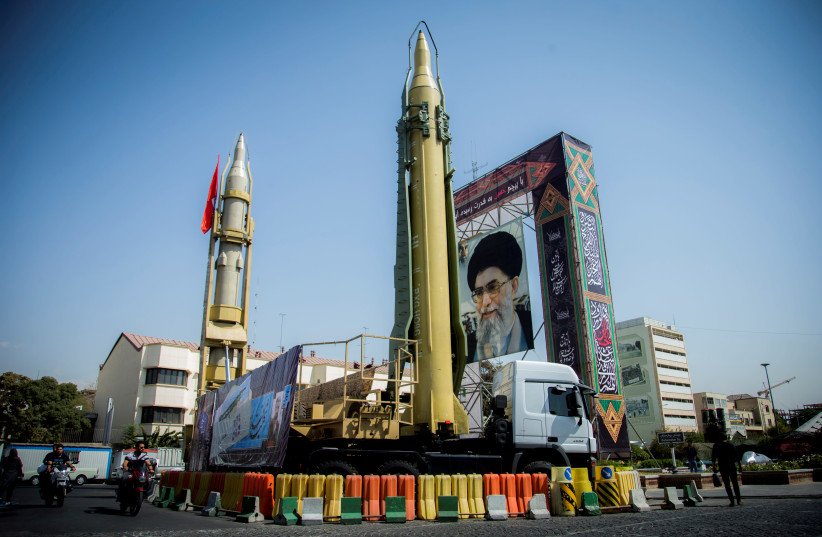It is important to pay attention to the nuclear policy announcements and threats coming out of Iran these days, but also to take them with a grain of salt.
All signs are that Iran Supreme Leader Ayatollah Ali Khamenei has finally reached the decision to return to the 2015 JCPOA nuclear deal and that the many recent hardline statements from Iranian officials are part of the Islamic Republic’s favorite negotiation strategy.
In essence, it is lots of screaming and kicking at the 11th hour to see if it can secure a few more concessions before it signs the dotted line.
In the worst-case scenario, where it gains little, Khamenei can at least present himself as having gone into the deal grudgingly and without naivete.
Also, Khamenei probably expects that most of his people will not follow many of the details and nuclear limits that he may agree to; they will, however, remember that he and his nuclear lieutenants sounded very tough and uncompromising in public.

Khamenei was a doubter of the 2015 deal up until the last moment when he allowed it to go forward.
In the days and weeks counting down to the signing of the deal, Khamenei unveiled harsher and louder nuclear threats, including spinning up an astounding 180,000 centrifuges to enrich uranium, far greater than the 20,000 they had at the time.
When he allowed then-Iranian foreign minister Javad Zarif to ink the nuclear deal, it really did seem like Tehran was being dragged to the bargaining table.
The known details of the deal also raise several questions at its 60-day and 165-day crossover points. Kicking and screaming into Day 0 is another good way for Khamenei to convey how tough he will be over the issue.
Why does Iran want to stall the deal so much?
Iran’s main concerns still seem to be getting the IAEA to close its probes of illicit nuclear material, equipment and documents at three nuclear sites. Iran likely wants to ensure that it fully benefits from sanctions relief, as opposed to post-2015, when it believed that the West indirectly undermined efforts by Western businesses to invest in the Islamic Republic.
Tehran’s public statements do not clarify whether it is close to a deal or has changed much of its positions since mid-2021.
In fact, the only way that observers know that Khamenei is close to a deal is that Iranians have played this game before, and keeping that in mind as they painstakingly follow its public statements and official negation positions. Anyone following would notice that, recently, he has allowed his officials to drop positions he had long stuck to.
What changed in Iran's echelon?
One Iranian official recently said there would be no “reimplementation day” unless the IAEA probes are closed. But reimplementation day is off into the distant future, and the old Iranian position was not signing anything until the probes are closed.
That position has been abandoned and all of the tough-sounding statements appear to be cover for that embarrassing retreat.
Likewise, on the issue of getting guarantees for sanctions relief, Khamenei fought for several months to get the IRGC delisted from the US terror list. Eventually, however, Iranian officials said that was not crucial for them and now they have completely stopped talking about it.
All of this was after trying and failing to get the Biden administration to give Iran a guarantee for remaining in the deal beyond his presidency.
Most of the guarantees being discussed now are much more limited, such as getting back billions of dollars frozen in South Korea and commitments by the US to allow Western private companies to maintain new contracts with Iran for some period of time, even if the US might later pull out again.
These are poor guarantees since the South Korean money would only go to Iran once it has reduced uranium enrichment from 60% to 20% – a trade-off offered by France many times in recent years, which Iran had repeatedly rejected.
Even the “guarantee” for companies could be easily repealed by a new US administration if the circumstances lined up in a certain way.
None of this means the West will actually get real answers from Khamenei about past military nuclear dimensions.
Mossad director David Barnea correctly noted last week that if the West signs a deal with a regime – regarding which it was 100% proven in 2018 from its own secret nuclear archives that it had lied to them about past nuclear dimensions – the West has already signaled that, at some point, they will put the issue on the back burner.
However, this does mean that, although now Iran insists that there are things it will not budge on, it may very well concede on those things in the near future.
